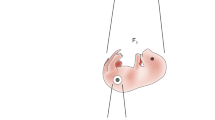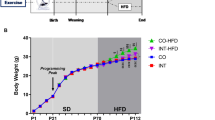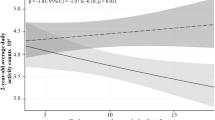Abstract
Background:
Maternal obesity (MO) impairs maternal and offspring health. Mechanisms and interventions to prevent adverse maternal and offspring outcomes need to be determined. Human studies are confounded by socio-economic status providing the rationale for controlled animal data on effects of maternal exercise (MEx) intervention on maternal (F0) and offspring (F1) outcomes in MO.
Hypothesis:
MO produces metabolic and endocrine dysfunction, increases maternal and offspring glucocorticoid exposure, oxidative stress and adverse offspring outcomes by postnatal day (PND) 36. MEx in part prevents these outcomes.
Methods:
F0 female rats ate either control or obesogenic diet from weaning through lactation. Half of each group wheel ran (from day 90 of life through pregnancy beginning day 120) providing four groups (n=8/group)—(i) controls, (ii) obese, (iii) exercised controls and (iv) exercised obese. After weaning, PND 21, F1 offspring ate a control diet. Metabolic parameters of F0 prepregnancy and end of lactation and F1 offspring at PND 36 were analyzed.
Results:
Exercise did not change maternal weight. Before breeding, MO elevated F0 glucose, insulin, triglycerides, cholesterol, leptin, fat and oxidative stress. Exercise completely prevented the triglyceride rise and partially increases glucose, insulin, cholesterol and oxidative stress. MO decreased fertility, recovered by exercise. At the end of lactation, exercise returned all metabolic variables except leptin to control levels. Exercise partially prevented MO elevated corticosterone. F1 offspring weights were similar at birth. At PND 36, MO increased F1 male but not female offspring leptin, triglycerides and fat mass. In controls, exercise reduced male and female offspring glucose, prevented the offspring leptin increase and partially the triglyceride rise.
Conclusions:
MEx before and during pregnancy has beneficial effects on the maternal and offspring metabolism and endocrine function occurring with no weight change in mothers and offspring indicating the importance of body composition rather than weight in evaluations of metabolic status.
This is a preview of subscription content, access via your institution
Access options
Subscribe to this journal
Receive 12 print issues and online access
$259.00 per year
only $21.58 per issue
Buy this article
- Purchase on SpringerLink
- Instant access to full article PDF
Prices may be subject to local taxes which are calculated during checkout






Similar content being viewed by others
References
Rasmussen KM, Catalano PM, Yaktine AL . New guidelines for weight gain during pregnancy: what obstetrician/gynecologists should know. Curr Opin Obstet Gynecol 2009; 21: 521–526.
Nguyen T, Lau DC . The obesity epidemic and its impact on hypertension. Can J Cardiol 2012; 28: 326–333.
McDonald SD, Han Z, Mulla S, Beyene J . Overweight and obesity in mothers and risk of preterm birth and low birth weight infants: systematic review and meta-analyses. BMJ 2010; 341: c3428.
Mendez MA, Monteiro CA, Popkin BM . Overweight exceeds underweight among women in most developing countries. Am J Clin Nutr 2005; 81: 714–721.
Boney CM, Verma A, Tucker R, Vohr BR . Metabolic syndrome in childhood: association with birth weight, maternal obesity, and gestational diabetes mellitus. Pediatrics 2005; 115: e290–e296.
Kirk SL, Samuelsson AM, Argenton M, Dhonye H, Kalamatianos T, Poston L et al. Maternal obesity induced by diet in rats permanently influences central processes regulating food intake in offspring. PLoS One 2009; 4: e5870.
Zambrano E, Martinez-Samayoa PM, Rodriguez-Gonzalez GL, Nathanielsz PW . Dietary intervention prior to pregnancy reverses metabolic programming in male offspring of obese rats. J Physiol 2010; 588: 1791–1799.
Bayol SA, Farrington SJ, Stickland NC . A maternal 'junk food' diet in pregnancy and lactation promotes an exacerbated taste for 'junk food' and a greater propensity for obesity in rat offspring. Br J Nutr 2007; 98: 843–851.
Wright TM, Fone KC, Langley-Evans SC, Voigt JP . Exposure to maternal consumption of cafeteria diet during the lactation period programmes feeding behaviour in the rat. Int J Dev Neurosci 2011; 29: 785–793.
Gardner B, Wardle J, Poston L, Croker H . Changing diet and physical activity to reduce gestational weight gain: a meta-analysis. Obes Rev 2011; 12: e602–e620.
Bodnar L, Parrott MS . Intervention strategies to improve outcome in obese pregnancies: micronutrients and dietary supplements. In Maternal Obesity Gillman MW, Poston L eds Cambridge University Press: New York, NY, USA, 2012. pp 119–208.
Nelson S, Poston L . Intervention strategies to improve outcome in obese pregnancies: insulin resistance and gestational diabetes. In Maternal Obesity Gillman MW, Poston L eds Cambridge University Press: New York, NY, USA, 2012. pp 179–198.
Oken E, Gillman MW . Intervention strategies to improve outcome in obese pregnancies: focus on gestational weight gain. In Maternal Obesity Gillman MW, Poston L eds Cambridge University Press: New York, NY, USA, 2012. pp 151–178.
McCance RA, Widdowson EM . Fat. Pediatr Res 1977; 11: 1081–1083.
Stern JS, Johnson PR . Spontaneous activity and adipose cellularity in the genetically obese Zucker rat (fafa). Metabolism 1977; 26: 371–380.
Miles JL, Landon J, Davison M, Krageloh CU, Thompson NM, Triggs CM et al. Prenatally undernourished rats show increased preference for wheel running v. lever pressing for food in a choice task. Br J Nutr 2009; 101: 902–908.
Miles JL, Huber K, Thompson NM, Davison M, Breier BH . Moderate daily exercise activates metabolic flexibility to prevent prenatally induced obesity. Endocrinology 2009; 150: 179–186.
Huber K, Miles JL, Norman AM, Thompson NM, Davison M, Breier BH . Prenatally induced changes in muscle structure and metabolic function facilitate exercise-induced obesity prevention. Endocrinology 2009; 150: 4135–4144.
Zambrano E, Bautista CJ, Deas M, Martinez-Samayoa PM, Gonzalez-Zamorano M, Ledesma H et al. A low maternal protein diet during pregnancy and lactation has sex- and window of exposure-specific effects on offspring growth and food intake, glucose metabolism and serum leptin in the rat. J Physiol 2006; 571: 221–230.
Guzman C, Cabrera R, Cardenas M, Larrea F, Nathanielsz PW, Zambrano E . Protein restriction during fetal and neonatal development in the rat alters reproductive function and accelerates reproductive ageing in female progeny. J Physiol 2006; 572: 97–108.
Rodriguez JS, Rodriguez-Gonzalez GL, Reyes-Castro LA, Ibanez C, Ramirez A, Chavira R et al. Maternal obesity in the rat programs male offspring exploratory, learning and motivation behavior: prevention by dietary intervention pre-gestation or in gestation. Int J Dev Neurosci 2012; 30: 75–81.
Bradford MM . A rapid and sensitive method for the quantitation of microgram quantities of protein utilizing the principle of protein-dye binding. Anal Biochem 1976; 72: 248–254.
Buege JA, Aust SD . Microsomal lipid peroxidation. Methods Enzymol 1978; 52: 302–310.
Perez-Severiano F, Salvatierra-Sanchez R, Rodriguez-Perez M, Cuevas-Martinez EY, Guevara J, Limon D et al. S-Allylcysteine prevents amyloid-beta peptide-induced oxidative stress in rat hippocampus and ameliorates learning deficits. Eur J Pharmacol 2004; 489: 197–202.
Ren XY, Li YN, Qi JS, Niu T . Peroxynitrite-induced protein nitration contributes to liver mitochondrial damage in diabetic rats. J Diabetes Complications 2008; 22: 357–364.
Clapp JF 3rd . Long-term outcome after exercising throughout pregnancy: fitness and cardiovascular risk. Am J Obstet Gynecol 2008; 199: e481–e486.
Gavard JA, Artal R . Effect of exercise on pregnancy outcome. Clin Obstet Gynecol 2008; 51: 467–480.
Kramer MS, McDonald SW . Aerobic exercise for women during pregnancy. Cochrane Database Syst Rev 2006; CD000180.
Dempsey JC, Butler CL, Sorensen TK, Lee IM, Thompson ML, Miller RS et al. A case-control study of maternal recreational physical activity and risk of gestational diabetes mellitus. Diabetes Res Clin Pract 2004; 66: 203–215.
Hopkins SA, Baldi JC, Cutfield WS, McCowan L, Hofman PL . Exercise training in pregnancy reduces offspring size without changes in maternal insulin sensitivity. J Clin Endocrinol Metab 2010; 95: 2080–2088.
Gilbert JS, Banek CT, Bauer AJ, Gingery A, Dreyer HC . Placental and vascular adaptations to exercise training before and during pregnancy in the rat. Am J Physiol Regul Integr Comp Physiol 2012; 303: R520–R526.
Gilbert JS, Banek CT, Bauer AJ, Gingery A, Needham K . Exercise training attenuates placental ischemia-induced hypertension and angiogenic imbalance in the rat. Hypertension 2012; 60: 1545–1551.
Iqbal M, Moisiadis VG, Kostaki A, Matthews SG . Transgenerational effects of prenatal synthetic glucocorticoids on hypothalamic-pituitary-adrenal function. Endocrinology 2012; 153: 3295–3307.
Gyllenhammer LE, Vanni AK, Byrd-Williams CE, Kalan M, Bernstein L, Davis J . Objective habitual physical activity and estradiol levels in obese latina adolescents. J Phys Act Health 2013; 10: 727–733.
Catalano PM, Farrell K, Thomas A, Huston-Presley L, Mencin P, de Mouzon SH et al. Perinatal risk factors for childhood obesity and metabolic dysregulation. Am J Clin Nutr 2009; 90: 1303–1313.
Crozier SR, Robinson SM, Godfrey KM, Cooper C, Inskip HM . Women's dietary patterns change little from before to during pregnancy. J Nutr 2009; 139: 1956–1963.
Godfrey KM, Barker DJ . Fetal programming and adult health. Public Health Nutr 2001; 4: 611–624.
Halliwell B, Gutteridge JM . Oxygen toxicity, oxygen radicals, transition metals and disease. Biochem J 1984; 219: 1–14.
Valko M, Leibfritz D, Moncol J, Cronin MT, Mazur M, Telser J . Free radicals and antioxidants in normal physiological functions and human disease. Int J Biochem Cell Biol 2007; 39: 44–84.
Fuchs B, Sommer N, Dietrich A, Schermuly RT, Ghofrani HA, Grimminger F et al. Redox signaling and reactive oxygen species in hypoxic pulmonary vasoconstriction. Respir Physiol Neurobiol 2010; 174: 282–291.
Wang XD, Vatamaniuk MZ, Wang SK, Roneker CA, Simmons RA, Lei XG . Molecular mechanisms for hyperinsulinaemia induced by overproduction of selenium-dependent glutathione peroxidase-1 in mice. Diabetologia 2008; 51: 1515–1524.
Berry CE, Hare JM . Xanthine oxidoreductase and cardiovascular disease: molecular mechanisms and pathophysiological implications. J Physiol 2004; 555: 589–606.
Sen S, Simmons RA . Maternal antioxidant supplementation prevents adiposity in the offspring of Western diet-fed rats. Diabetes 2010; 59: 3058–3065.
Szostak J, Laurant P . The forgotten face of regular physical exercise: a 'natural' anti-atherogenic activity. Clin Sci (Lond) 2011; 121: 91–106.
Igosheva N, Abramov AY, Poston L, Eckert JJ, Fleming TP, Duchen MR et al. Maternal diet-induced obesity alters mitochondrial activity and redox status in mouse oocytes and zygotes. PLoS One 2010; 5: e10074.
Rebuffe-Scrive M, Walsh UA, McEwen B, Rodin J . Effect of chronic stress and exogenous glucocorticoids on regional fat distribution and metabolism. Physiol Behav 1992; 52: 583–590.
Tomlinson JW, Walker EA, Bujalska IJ, Draper N, Lavery GG, Cooper MS et al. 11beta-hydroxysteroid dehydrogenase type 1: a tissue-specific regulator of glucocorticoid response. Endocr Rev 2004; 25: 831–866.
McMullen S, Langley-Evans SC, Gambling L, Lang C, Swali A, McArdle HJ . A common cause for a common phenotype: the gatekeeper hypothesis in fetal programming. Med Hypotheses 2012; 78: 88–94.
Panidis D, Tziomalos K, Papadakis E, Vosnakis C, Chatzis P, Katsikis I . Lifestyle intervention and anti-obesity therapies in the polycystic ovary syndrome: impact on metabolism and fertility. Endocrine 2013 doi:10.1007/s12020-013-9971-5.
Bermejo-Alvarez P, Rosenfeld CS, Roberts RM . Effect of maternal obesity on estrous cyclicity, embryo development and blastocyst gene expression in a mouse model. Hum Reprod 2012; 27: 3513–3522.
Moran LJ, Pasquali R, Teede HJ, Hoeger KM, Norman RJ . Treatment of obesity in polycystic ovary syndrome: a position statement of the Androgen Excess and Polycystic Ovary Syndrome Society. Fertil Steril 2009; 92: 1966–1982.
James WH . Further evidence that some male-based neurodevelopmental disorders are associated with high intrauterine testosterone concentrations. Dev Med Child Neurol 2008; 50: 15–18.
Carter LG, Lewis KN, Wilkerson DC, Tobia CM, Ngo Tenlep SY, Shridas P et al. Perinatal exercise improves glucose homeostasis in adult offspring. Am J Physiol Endocrinol Metab 2012; 303: E1061–E1068.
Gillman MW, Poston L . Maternal obesity. Cambridge University Press: New York, NY, USA, 2012.
Acknowledgements
CCV is graduate student from posgrado de Ciencias Químico-Biológicas de la ENCB del Instituto Politécnico Nacional and is recipient of Consejo Nacional de Ciencias y Tecnología (CONACyT) fellowship. LARC and CJB are graduate students from Doctorado en Ciencias Biomédicas, Facultad de Medicina, Universidad Nacional Autónoma de México and are recipients of CONACyT fellowship; this work was supported by CONACyT 155166, México, Sociedad Mexicana de Nutrición y Endocrinología and HD 21350 from the National Institute of Child Health and Human Development.
Author information
Authors and Affiliations
Corresponding author
Ethics declarations
Competing interests
The authors declare no conflict of interest.
Additional information
AUTHOR CONTRIBUTIONS
CCV researched data; LAR researched data; CJB researched data; FL contributed to discussion and reviewed manuscript; PWN study design, manuscript writing; and EZ study design, wrote the manuscript.
Supplementary Information accompanies this paper on International Journal of Obesity website
Supplementary information
Rights and permissions
About this article
Cite this article
Vega, C., Reyes-Castro, L., Bautista, C. et al. Exercise in obese female rats has beneficial effects on maternal and male and female offspring metabolism. Int J Obes 39, 712–719 (2015). https://doi.org/10.1038/ijo.2013.150
Received:
Revised:
Accepted:
Published:
Issue Date:
DOI: https://doi.org/10.1038/ijo.2013.150



